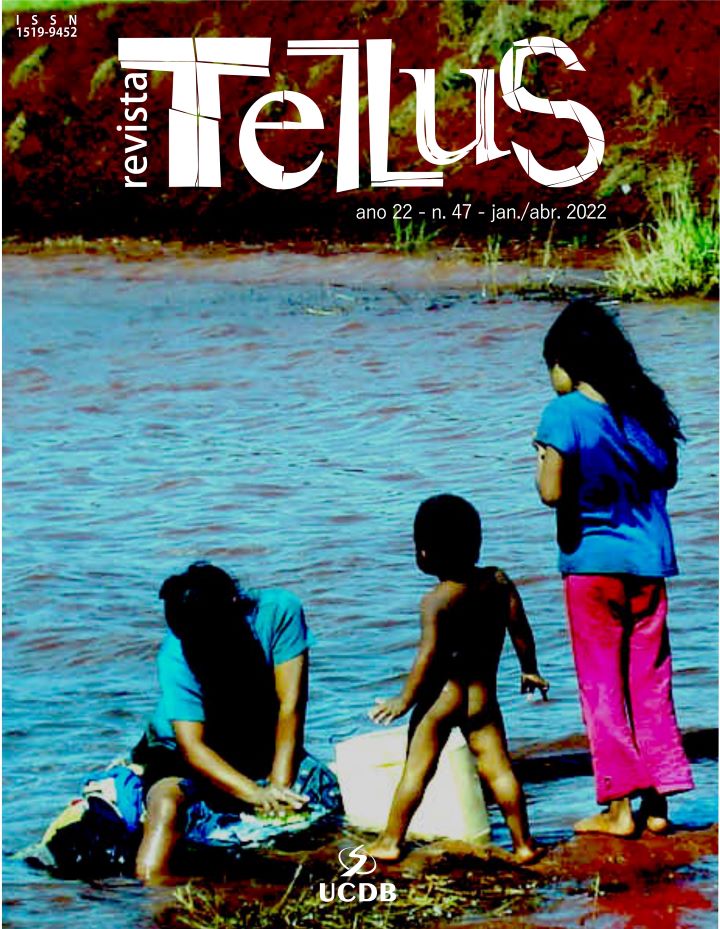“Shaman-woman”: Cosmopolitics of the body at the party of the wira’u haw Tenetehar- Tembé
DOI:
https://doi.org/10.20435/tellus.v22i47.771Keywords:
shaman-woman, body, cosmopolitics, party of the wira’u hawAbstract
This article analyzes the body transformation/fabrication processes of the woman Tembé in the feast of the Wira'u Haw to constitute “shaman-woman”. Based on the notion of person and corporeality, the ethnography of the ritual in the Teko-Haw and Sede villages, and the mythical narratives, I try to understand the agencies, the points of view, and the capacities that the bodies of the “young girls” potentiate, in the co-relations with the Karuwar(s): Zawar/jaguar/shaman and Zahy/moon/shaman, and with the spirit of Verônica Tembé in the sociocosmic system. It is through the cosmopolitics of the body that the “young girl”, in the three phases of the ritual, the stakeout, the porridge festival, and the festival of the moqueado, learns, with the “old women”, to build her co-existence of woman-shaman.
References
BELAUNDE, L. E. A força dos pensamentos, o fedor do sangue: hematologia e gênero na Amazônia. Revista de Antropologia, São Paulo, v. 49, n. 1, p. 1-39, 2006. Disponível em: http://dx.doi.org/10.1590/S0034-77012006000100007. Acesso em: 15 de abril de 2020. DOI: https://doi.org/10.1590/S0034-77012006000100007
BENITES, S. Viver na língua Guarani Nhandeva (mulher falando). 2018. Dissertação (Mestrado em Antropologia Social) - Museu Nacional, Universidade Federal do Rio de Janeiro, Rio de Janeiro, 2018.
COLPRON, A. Dichotomies sexuelles dans l'étude du chamanisme: le contre-exemple des femmes chamanes shipibo-conibo. 2004. Thèse. (Doctorat en anthropologie sociale) - Université de Montréal, Montréal, 2004.
FAUSTO, C. Banquete de gente: comensalidade e canibalismo na Amazônia. Mana, v. 8, n. 2, p. 7-44, 2002. Disponível em: https://doi.org/10.1590/S0104-93132002000200001. Acesso em 20 de abr. de 2002. DOI: https://doi.org/10.1590/S0104-93132002000200001
GOW, P. O parentesco como consciência humana: o caso dos piro. Mana, v. 3, n. 2, p. 39-65, 1997. Disponível em: http://www.scielo.br/pdf/mana/v3n2/2440.pdf. Acesso em: 10 mai. 2020. DOI: https://doi.org/10.1590/S0104-93131997000200002
GRÜNEWALD, L. A ‘cosmo/política’ ameríndia. Indiana, v. 33, n. 2, p. 119-42, 2016. Disponível em: https://doi.org/10.18441/ind.v33i2.119-143. Acesso em: 02 nov. 2020.
HAMAYON, R. N. "Shamanism in Siberia: from partnership in supernature to counter-power in society". In: THOMAS, N.; HUMPHREY, C. (Ed.). Shamanism, History and the State. Ann Arbor: University of Michigan Press, 1994.
LAGROU, E.; VELTHEM, L. H. VAN. Artes indígenas: olhares cruzados. BIB – Revista Brasileira de informação bibliográfica em Ciências Sociais. São Paulo, v.87, n.3, p. 133-56, 2018. Disponível em: https://doi.org/10.17666/ bib8706/2018. Acesso em: 17 de ago. 2021.
LAGROU, E. A fluidez da forma: arte, alteridade e agência em uma sociedade amazônica (Kaxinawa, Acre). Rio de Janeiro: Topbooks, 2007.
MALUF, S. W. A antropologia reversa e “nós”: alteridade e diferença. Ilha – Revista de Antropologia, Florianópolis, v. 12, n. 1, p. 40-56, 2011. Disponível em: https://doi.org/10.5007/2175-8034.2010v12n1-2p41. Acesso em: 20 de agos. de 2020. DOI: https://doi.org/10.5007/2175-8034.2010v12n1-2p41
MAUÉS, R. H.; MAUÉS, M. A. M. O modelo da "reima": representações alimentares em uma comunidade amazônica. Anuário Antropológico, Brasília, v. 2, n. 1, p. 120–47, 2018. Disponível em: https://periodicos.unb.br/index.php/anuarioantropologico/article/view/6016 . Acesso em: 22 ago. 2021.
MAUÉS, R. H. O Perspectivismo indígena é somente indígena? Cosmologia, religião, medicina e populações rurais na Amazônia. Mediações, Londrina, v. 17, n. 1, p. 33-61, 2012. Disponível em: https://doi.org/10.5433/2176-6665.2012v17n1p33. Acesso em: 01 de jun. 2019. DOI: https://doi.org/10.5433/2176-6665.2012v17n1p33
MAUÉS, R. H. Medicinas populares e "pajelança cabocla" na Amazônia. In: ALVES, P. C; MINAYO, M. C. S. (Org.). Saúde e doença: um olhar antropológico. Rio de Janeiro: FIOCRUZ, p. 73-81, 1994. [E-book]. Disponível em: https://static.scielo.org/scielobooks/tdj4g/pdf/alves-9788575412763.pdf . Acesso em: 22 ago. 2021.
MAUÉS, R. H. A ilha encantada: medicina e xamanismo numa comunidade de pescadores. Belém: Edufpa, 1990.
PÉREZ GIL, L. Metamorfoses Yaminawa: xamanismo y socialidade na Amazônia Peruana. 2006. Tese (Doutorado em Antropologia Social) - Universidade Federal de Santa Catarina, Florianópolis, 2006.
PERRUCHON, M. "Llegar a ser una mujer-hombre". In: PERRIN, M; PERRUCHON, M. (Org.). Complementariedad entre hombre y mujer. Relaciones de género desde la perspectiva ameríndia. Quito: Abya-Yala, 1997, p. 47-108.
SEEGER. A.; DA MATTA, R; VIVEIROS DE CASTRO, E. A construção da pessoa nas sociedades indígenas brasileiras. boletim do Museu Nacional – Antropologia, Porto Nacional, n. 32, 1979.
SOARES-PINTO, N. De Coexistências: sobre a constituição de lugares Djeoromitxi. Revista de @ntropologia da UFSCar, São Carlos, v. 9, n.1, p. 61-82, 2017. DOI: https://doi.org/10.52426/rau.v9i1.180
VIDAL, L. B. As artes indígenas e seus múltiplos mundos. Revista do Patrimônio Histórico e Artístico Nacional, Rio de Janeiro, n. 29, p. 11-41, 2001.
VIVEIROS DE CASTRO, E. B. Metafísicas Canibais: elementos para uma antropologia pós-estrutural. São Paulo, SP: UBU Editora; N-I edições, 2018.
VIVEIROS DE CASTRO, E. B. “No Brasil, todo mundo é índio, exceto quem não é”. São Paulo: Instituto Sócio Ambiental, 2006. Disponível em: https://pib.socioambiental.org/files/file/PIB_institucional/No_Brasil_todo_mundo_%C3%A9_%C3%ADndio.pdf Acesso em : Acesso em: 22 ago. 2021.
VIVEIROS DE CASTRO, E. B. A Inconstância da Alma Selvagem e Outros Ensaios de Antropologia. São Paulo: Cosac Naify, 2002.
VIVEIROS DE CASTRO, E. B. Os pronomes cosmológicos e o perspectivismo ameríndio. Mana, Rio de Janeiro, v. 2, n. 2, p 115-44, 1996. DOI: https://doi.org/10.1590/S0104-93131996000200005
Downloads
Published
How to Cite
Issue
Section
License
Todos os artigos publicados na Revista Tellus estão disponíveis online e para livre acesso dos leitores, tem licença Creative Commons, de atribuição, uso não comercial e compartilhamento pela mesma. Direitos Autorais para artigos publicados nesta revista são do autor, com direitos de primeira publicação para a revista. Em virtude de aparecerem nesta revista de acesso público, os artigos são de uso gratuito, com atribuições próprias, em aplicações educacionais e não-comerciais.


